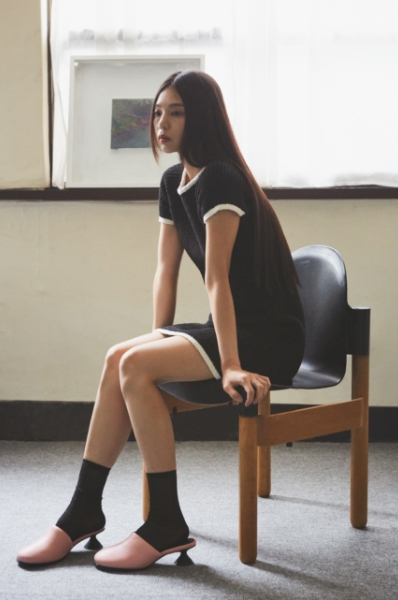Special Report – Korea Published on
Special Report – Korea 🇰🇷
Live from the Market
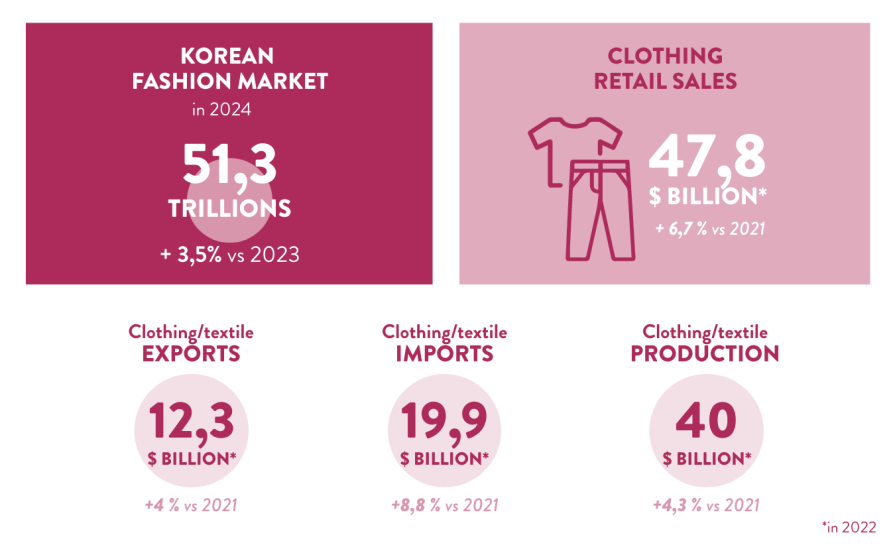
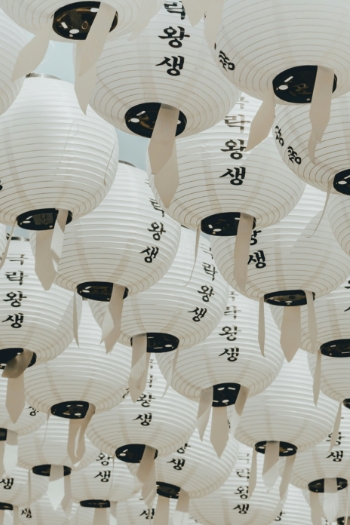
Uncertainty is increasing in the global economy due to heightened tensions in the Middle East following the recent Russian-Ukrainian war, resulting in high interest rates and inflation.
The U.S. and Europe are the main destinations of demand for the textile and fashion industry. As the consumption in these destinations decreases and inventory increases, the sourcing for sowing labour from Asia is decreasing and exports of Korean materials are decreasing in tandem.
Korean textile and fashion companies are experiencing difficulties in the domestic market as competition intensifies and profitability declines due to high wages and labour shortages.
Specifically, due to the increase in imports of Chinese materials, some chemical fibre companies have stopped producing general-purpose items. The clothing sewing industry is in a situation of shrinkage due to the expansion of overseas production.
Moreover, this industry is exposed to a vicious cycle of risks to supply chain of raw material and production decline due to shrinking demand in the domestic market.
According to trade statistics from the Korean International Trade Association, Korea’s textile, and clothing exports in 2022 recorded $12.3 billion, down 4.0% from the previous year due to the global economic downturn, and imports increased by 8.8% to $19.9 billion.
In the case of demand in the domestic markets, clothing retail sales in 2022 recorded $47.8 billion, up by 6.7% from the previous year. Due to rising import prices and increased demand for expensive clothing.
Online shopping transaction volume increased by 11.1% from the previous year to $14.4 billion. Mobile shopping was recorded at $10.9 billion, and internet shopping was recorded at $3.4 billion.
Textile and clothing production in 2022 was $40 billion, down 4.3% from the previous year due to worsening domestic profitability and the relocation of production facilities overseas.
Meanwhile, as Korean culture (K-culture), including K-pop, K-content, and K-food, is gaining global popularity, interest in and the awareness of K-fashion is also increasing. It is expected to attract attention in the EU and Asia, which will help develop the domestic industry into a textile and fashion powerhouse.
Among Korean cultural (K-culture) contents, overseas consumers’ spending on fashion ranks first. It ranks fourth in popularity, leading the Korean wave along with food (Korean food), beauty (cosmetics), and music (K-POP).
The coronavirus pandemic, which has lasted three years since 2020, has changed many aspects of our lives. As I learnt the importance of basic immunity along with the importance of vaccines and masks to protect myself from powerful viruses. I naturally became interested in healthy food, lifestyle, and exercise.
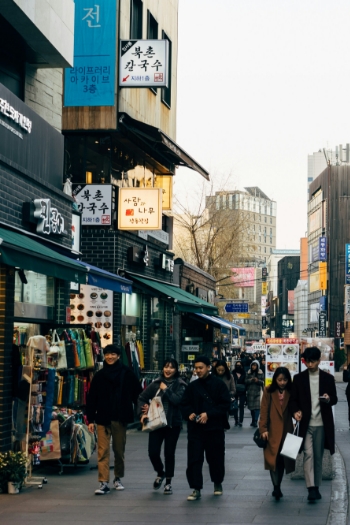
As young consumers become interested in sports such as golf, hiking, fishing, and tennis, which were previously considered to be exclusive to the middle-aged. ‘Healthy Pleasure,’ which promotes healthy living and enjoying staying healthy through social media, has emerged as a new trend.
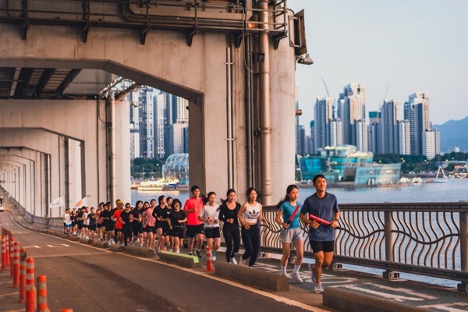
In addition, as the number of people working from home increased due to the COVID-19 pandemic, the demand for casual clothes saw an increase.
Especially clothes that blurred the boundaries between indoor wear, sportswear, and everyday wear for consumers who experienced comfort in activities increased. As the boundaries between daily life, hobbies, and exercise collapsed. The leisure look became extremely popular and became the leader in growth of the fashion industry.
In the fashion industry in 2023, the casual wear market led growth by attracting outerwear customers who prefer both street and sports sensibilities to the market. In addition, the shoe market, where consumption has increased centring on fashion sneakers released by sports companies, and the sportswear market, which has been steadily growing as outdoor activities increase due to the recovery of daily life. This can also be seen as leading the growth of the fashion industry.
According to a trend research agency, the size of the Korean fashion market in 2024 is expected to reach KRW 51.3 trillion, up by 3.5% from 2023, the largest ever increase. This figure is more than 2.5 times more than the 21 trillion won in 2000.
As the Y2K fashion trends continue in 2024, it is expected that it will be upgraded to suit the tendencies of the younger generation. In addition, as outdoor activities which had been curtailed over the past three years, are explosively increasing the strength of activewear. Since they can be easily worn in real life, it is expected to be seen more often in looks with diversity. Additionally, as offline events increase following the COVID-19 pandemic, demand for suit set-up and practical jacket styles is expected to steadily increase.
In women’s clothing, retro designs with feminine details that were popular in the early 2000s, such as back tops that emphasise the back design rather than the front, are expected to attract attention once again. Not to mention, square neck and tied up looks in colours that stand out but have a cosy atmosphere, such as peach, orange, and deep sky, are also expected to re-emerge.
Also, the caftan with voluminous sleeve design in magenta, sky blue, bright yellow, and white colours and the trousers fastened with a waist strap are mainly made of linen fabric for a cool look. As well as, the loose fit provides comfortable movement, making it perfect for outdoor activities.
The suit set-up in pastel colours such as ivory, baby pink, and light green can give points with an understated cut design, twists, and wrinkles, as well as the linen fabric keeping you cool with the soft colours creating a modern and luxurious atmosphere.
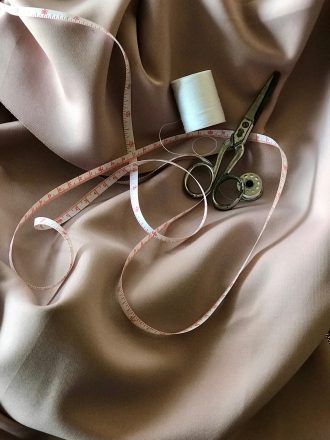
A comfortable jacket with a cargo design creates a relaxed silhouette. Smart jogger trousers with an emphasis on functionality, skirts with pocket details, and hybrid jackets were mixed and matched with brown and cargo colours. Additionally, the light and soft fabric adds coolness.
Furthermore, the ‘Old Money Look’, which is characterised by a sophisticated design and luxurious fabrics such as silk, cashmere, linen, and tweed. Instead of flashy logos or colours, the ‘Old Money Look’ is still popular and is being talked about as a fashion trend among the younger generation and celebrities
In men’s clothing, the utility trend is expected to continue following last season, which provides practical and utility clothing. On the other hand, streetwear has virtually disappeared from men’s wardrobes. With workwear, coming into the spotlight.
By applying pocket decorations, zippers, drawstrings, and belt details to formal items, it goes beyond casual and evolves into chic tailoring. A sweet sensibility is conveyed with bold flower print shirts, flower-pointed jackets, and flower-decorated corsages. Feminine tailoring and cutting are also expected to become bolder.
As the shorts trend has continued for several seasons, this year we are expected to see a contrast between shorter micro shorts and various oversized jackets. In addition, tweed, a woollen fabric with a luxurious texture, and crochet knit materials are also rapidly emerging as items that will attract attention.
In 2024, sustainability is expected to become more important than ever as value consumption becomes the focus. Where consumers purchase products based on their own values, resulting in a shakeup of the market. Consumers will increasingly seek out sustainable and ethically produced products, which will force brands to adopt more sustainable practices in their supply chains.
Consumption of products made with recycled fibres spun from waste plastic bottles or waste fishing nets, nature-friendly biodegradable fibres, and zero-waste designs that minimise waste during the clothing production process is expected to continue to increase. Furthermore, various attempts to revive discarded materials such as vegan leather extracted from natural materials namely mushroom mycelium and cactus, military tents, parachutes, and automobile airbags from a fashionable perspective are expected to attract the attention of consumers.
The Korean Consumer Agency conducted a survey of 1,000 adult men and women in their 20s to 60s nationwide in April 2023, and 90.7% of consumers responded that they were willing to purchase eco-friendly products. In particular, 95.3% of respondents responded that they would purchase eco-friendly products even if the price was somewhat more expensive than regular products.
Experts predict that this trend will continue this year following last year, and that value consumption will be strengthened in consumers’ consumption patterns.
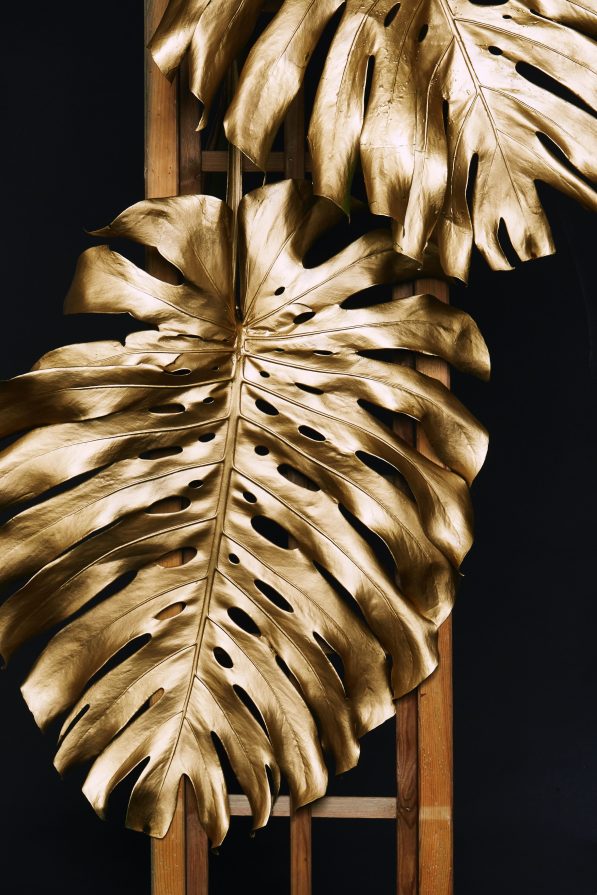
Accordingly, fashion beauty companies are also responding to consumer demand by launching various eco-friendly brands and releasing new products.
Meanwhile, the polarisation of the fashion market is worsening as the mid-priced clothing market falls into a recession. Due to the expansion of the parallel market for overseas luxury goods and high-end clothing. Consumers whose wallets have become thin due to high inflation rates have no choice but to prefer cost-effective products.
Recently, many young consumers are visiting offline spaces to experience the feeling, emotion, and the experience of the space itself, rather than going to offline spaces to shop for products. Meanwhile, new online brands that have been launched only a few years ago are capturing the hearts of consumers with differentiated concepts and are growing steadily.
As economic uncertainty and consumer sentiment decline are expected, a more integrated concept of wellness is attracting attention as lifestyles change toward leading a good life, including good clothes. In the fashion market of 2024, fashion trends that provide comfort and soothe tired senses amidst an uncertain future and climate crisis are expected to garner attention.
Written by M. Sanghyun KIM, February 28th of 2024
Ones to watch (very) closely…
Discover our selection of brands making waves on the Korean market
The eye of Tranoï
Tranoï, the trade show partner specializing in young international designers, shares its pick of emerging Korean-based brands to follow
FINOACINQUE
Accessories / Shoes
Founded in 2019, Finoacinque is a footwear label that takes the concept of comfort to a new level. It is known for the original shapes of its shoe designs, with heels of up to 5 cm.
Inspired by ’60s fashion, and the Twiggy aesthetic, Finoacinque’s collections reflect the brand’s five key watchwords: Comfort, Uniqueness, Craftsmanship, Timelessness and Durability.
ETHOS
Ready to Wear / Women
Specializing in wearable materials and structures that can add a new dimension to everyday life, the Ethos label is named after the most important of Aristotle’s three rhetorical appeals: ETHOS is synonymous with empathy and trustworthiness.
HYERI
Accessories / Jewelry
HYERI offers modern, timeless pieces that will pass on memories to be treasured by the next generation.
For brand founder Hyeri Kim, jewelry is imbued with sentimental and emotional value, as it carries the stories of the previous wearers.

